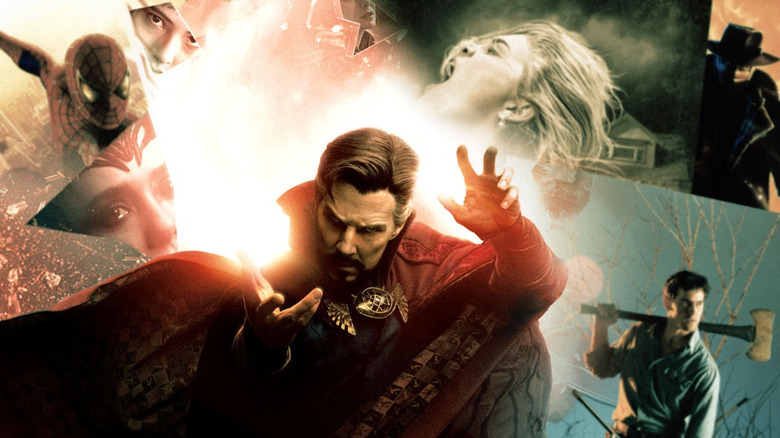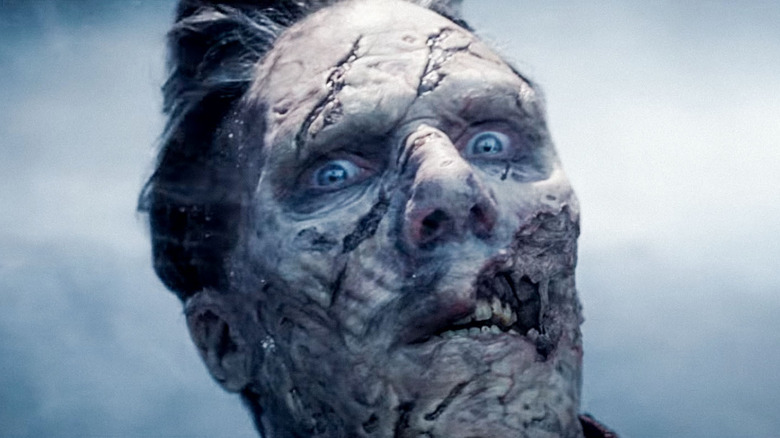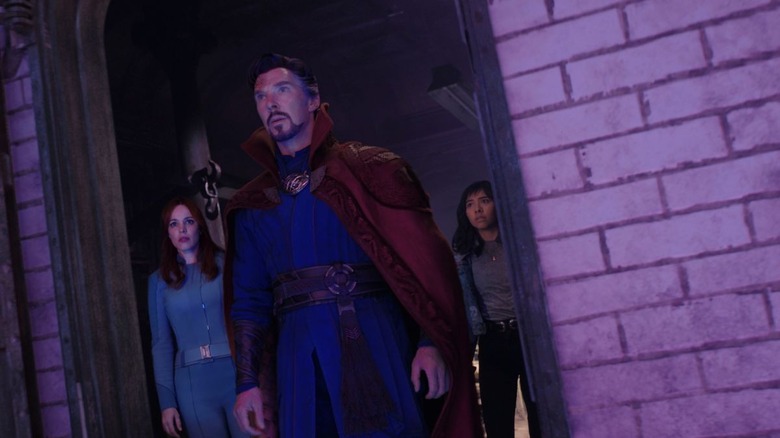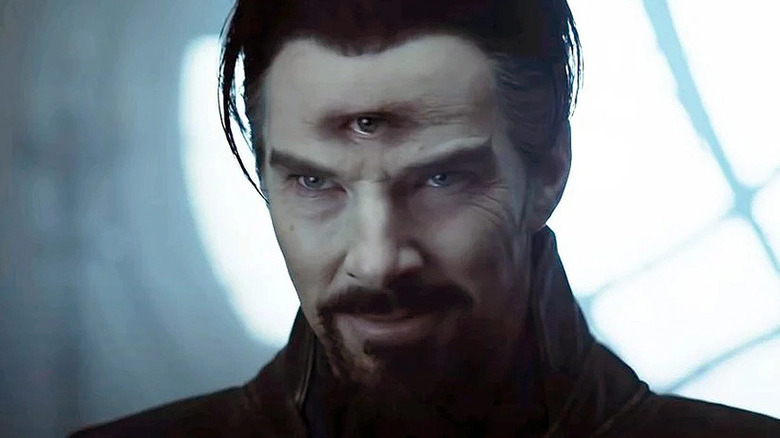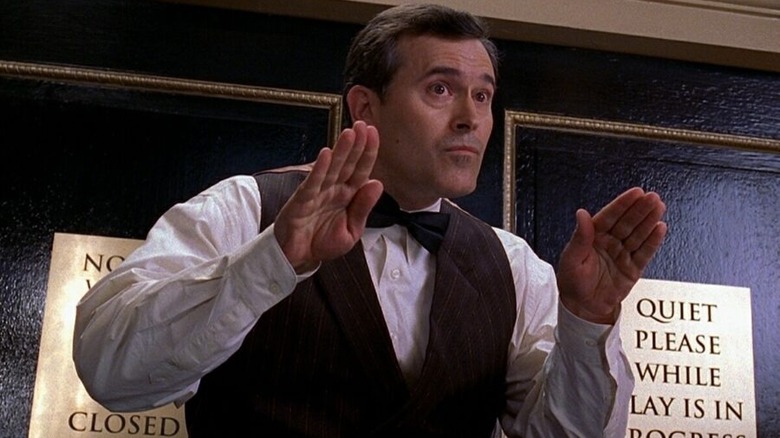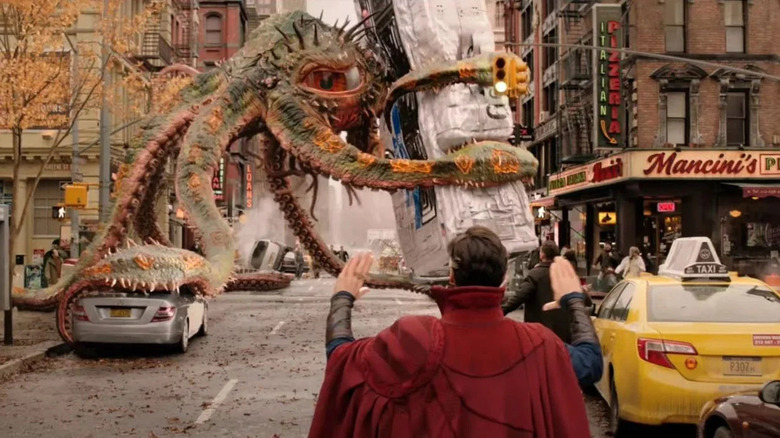How Much Of A Sam Raimi Movie Is Doctor Strange In The Multiverse Of Madness?
"Doctor Strange in the Multiverse of Madness" is officially in theaters, and with Sam Raimi as director, many are curious to see how well his signature style comes through amid the Marvel Cinematic Universe formula. There will absolutely be spoilers ahead, so if you don't want to know plot points, please save this article and watch the film first.
In "Multiverse of Madness," Doctor Stephen Strange (Benedict Cumberbatch) is dealing with a rogue Wanda Maximoff, aka Scarlet Witch, who is trying to steal the powers of America Chavez (Xochitl Gomez), who can blast open star-shaped portals to other parts of the multiverse — but only when she's terrified. Wanda just wants to be with her children again, but let's just say that while her motives make a kind of twisted sense, her methods are pretty awful. Strange and America travel through the multiverse trying to stop her, and huge battles ensue. Oh, and there's a cursed book that brings doom on anyone who tries to read it. If that isn't open to Sam Raimi's signature style, I don't know what Marvel movie is!
Raimi, now with extra Raimi
"Doctor Strange in the Multiverse of Madness" is a Raimi film in the same way "Thor: Ragnarok" was a Taika Waititi film or "Guardians of the Galaxy" is a James Gunn film. It's about as Raimi-esque as it is possible to be, given the constraints of the MCU. As Raimi himself explained in an interview with /Film:
"This is an existing series with established characters and a fan base. And the job is to complete mile 16 of a bridge that had been under construction for 15 years. And it takes a different set of skills to do that. It's got to work with what went before. It's got to lead into what's coming. It's got to be handled to hold the same audience expectations that those other films did."
Despite these demands, Raimi still managed to put his personal touch on "Multiverse of Madness." Let's start with the darkness/horror levels here. Obviously Raimi is associated with horror thanks to movies like the "Evil Dead" trilogy and "Drag Me to Hell," and there is a lot of horror DNA in this film. Many fans have been asking for a darker MCU film, and while "Doctor Strange in the Multiverse of Madness" retains Raimi's sense of humor, there are definitely enough scary elements that I wouldn't necessarily bring your little ones to this film. Someone gets cut in half, eyeballs get skewered, screaming souls of the damned reach out with ghostly fingers to drag people to hell — that sort of thing (though the blood is kept to a minimum).
One thing Raimi is really good at throughout his films is making scary stuff very personal and visceral. He uses POV shots to give the audience a front seat when scary things happen, as Hitchcock used to do. (Think about the shower scene in "Psycho," where we see the hand and the knife, but it's not an overhead shot — you feel like you're right in it.) Raimi once again uses a subjective camera angle in "Multiverse of Madness." In the scene with the souls of the damned floating around an undead Doctor Strange, you feel like they're coming at you, the audience member.
We've definitely got an "Evil Dead" franchise feel here with the spirits, with hands reaching out of the ground like Deadites, the skittering they do, flying around with high-pitched laughter, and people swatting at them. Even Dead Strange is a Deadite of sorts, and as he does sometimes in his other films, Raimi has him speaking almost directly to the camera at times. We don't cut away from his decaying face at all while he does a monologue. There is no shadow that hides him. He's just there, with half of his face gone, teeth apparent. Even Wanda (Elizabeth Olsen), as she gets more and more evil, begins to look like a zombie — drained of the joy in life that kept her in her imaginary world with her children in "WandaVision."
Zolly zombies
A lot of his camera work in "Doctor Strange in the Multiverse of Madness" is what we've come to expect from Raimi. In addition to fast and sudden zooms in general, there's a specific technique he uses a lot called a dolly zoom, vertigo shot, or "zolly shot." This is when the zoom lens is pushed in while camera itself moves away (or vice versa), and the resulting effect creates the impression that the world itself is shifting. Our brains recognize this movement as impossible and unnatural, and it causes a sense of unease and disorientation in the viewer.
Think about how we saw Peter Parker's (Tobey Maguire) Spider-Sense shown in the Raimi "Spider-Man" films. For instance, the scene where he and Mary Jane (Kirsten Dunst) are sitting in the cafe, and he realizes the car is coming in through the window. The shot zooms out, but we also zoom in on his face. In "Multiverse of Madness," we see this with the tentacles in the Gargantos attack scene, as Strange reaches for the light post, and as the camera tracks past Strange into the eye.
We also get a lot of Dutch angles, where the camera is tilted to the right or left, as it does when Christine, America, and Strange are running through hallways as they're being chased by Scarlet Witch. Like the zolly shot, Dutch angles are contrary to the "rules" of how we usually see the world and give the illusion of everything being off-kilter, like the tilted hallways in funhouses.
Keeping with the funhouse theme, Raimi uses a lot of swirling shots to give a feeling of unreality, as he does when Ash gets possessed by a Deadite in "Evil Dead II." It happens in "Doctor Strange" with the dead spirits swirling around Strange, or at the beginning of the trailer, where the camera spins around a door to the space between the universes (called the "gap junction") where the Book of Vishanti resides. There are also a lot of camera speed changes to punctuate a realization, like the moment Wanda realizes that she's trapped in the mirrors, or in the moments as Strange and America drift through universes.
Into the eyes of madness
Sam Raimi is a big fan of extreme close-ups on eyes (as seen, for example, with Willem Dafoe's Green Goblin in "Spider-Man"), and those find their way into "Multiverse of Madness." In one such shot, we go directly into a shot of Wanda's eye, reflecting what she's seeing in Christine's lab. Raimi is the master of clever transitions, and the eye close-ups play into this as well; you get a close shot into the eye that then transitions into another scene (or vice versa).
Extreme closeups like this give a sense of panic (something that close talkers do to me for the same reason), because you lose your sense of personal space. Raimi's use of close-ups during particularly dramatic moments also alights on the idea of making tragedy or death or pain more personal, and therefore more real and powerful. You make the viewer feel like they're there, and they're more likely to remember it.
Bruuuuuuce!
Of course there is a Bruce Campbell cameo in here! Raimi puts the "Evil Dead" star in most of his films if he can, and "Doctor Strange in the Multiverse of Madness" is no exception. Campbell plays a street food vendor called Pizza Poppa in the Earth-838 universe that Doctor Strange and America Chavez visit. Pizza is not served in slices there, but instead in balls. I don't know that I would be willing to eat that, or how it even works, physics-wise. Does the cheese slide everywhere? Where is the bread? How does it stay in a ball-shape? I have questions. Whatever the science behind pizza balls is, Campbell's Pizza Poppa is selling them off a food cart.
His cameos are often funny, like the snooty usher in "Spider-Man 2," or the Winkie Guard in "Oz the Great and Powerful," and this one is no exception. Pizza Poppa wants to get paid for his pizza balls, but America didn't realize that food costs money in this universe. Then Strange makes him continually punch himself in the face (it will wear off in a month or so) for getting mad at them for stealing his balls. You have to feel for Mr. Poppa. He's just trying to sell his balls in peace, and a wizard and a kid come along and just take them? How's a pizza ball cart owner supposed to do business that way?
Love and monsters
Sam Raimi is obviously an old hand at monster scenes and making you feel like they're right there next to you. The Gargantos fight makes you feel the way the Deadites did: right on top of you, and moving with speed. The tentacles are right in your face in the battle. If you revisit Doctor Octopus (Alfred Molina) in "Spider-Man 2", you'll see shots of those arms coming at you in the same way. It's all part of Raimi's visual language. The same goes for the grasping hands in the cape of damned souls that Dead Strange wears.
One more crucial thing that Raimi does, though it's often not commented on, is center his horror emotionally. It's classic storytelling. Though the story might not be grounded in reality, his characters are genuine (if larger than life), and love is often a big part of his stories, from the found family themes of "Ash vs. Evil Dead," to how Peter and MJ work things out in the "Spider-Man" movies.
In "Doctor Strange," America finds a new family through her friendship with Strange(s). Though Steven realizes that he and Christine are never going to work it out in any universe, their parting isn't volatile or angry. There is a sense of sweetness as he tells her, "I love you ... in every universe." It's earnest, and it's lovely. Sure, everyone loves a big, bombastic story, but at the heart of it, storytelling is about relationships. Even the moment Steven thinks that maybe this other universe's version of Mordo (Chiwetel Ejiofor) might be close to the other Strange is sweet (though ultimately wrong). Or the moment Black Bolt (Anson Mount) executes Earth-838's Strange, and does so with an apology for hurting his friend.
Sure, "Doctor Strange in the Multiverse of Madness" is a Marvel film, and gore isn't really a part of that mostly kid-friendly world. We have dust instead of blood most of the time, and more of a sense of weirdness than gory horror, but this is about as Raimi as you can get in the MCU, and his stamp is all over it.
"Doctor Strange in the Multiverse of Madness" is in theaters now.
